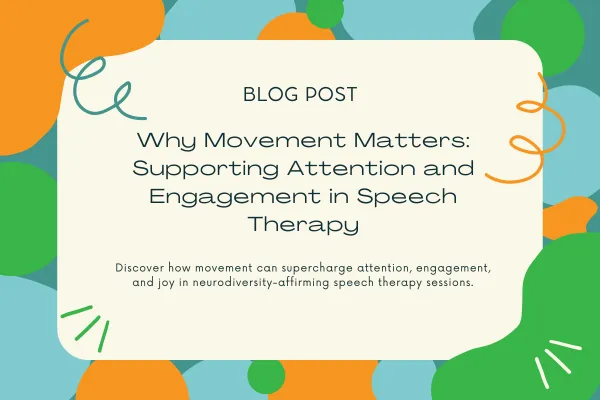
Why Movement Matters: Supporting Attention and Engagement in Speech Therapy
Why Movement Matters: Supporting Attention and Engagement in Speech Therapy
When you think about speech therapy, what comes to mind? Maybe picture books, speech sounds, or sitting across from a child at a table with flashcards. But what if we told you that one of the most powerful tools we have to support communication, engagement, and learning… is movement?
At our Friday Power Hour, we dove into how movement isn’t just a “nice to have”—it’s a core strategy for boosting attention, connection, and outcomes in speech therapy sessions. Whether you’re working with neurodivergent children, kids with sensory differences, or simply curious little humans, movement can be the magic ingredient that brings therapy to life.
Let’s explore the key takeaways.
💡 Movement is Regulating
One of the simplest but most powerful reminders: movement helps the body regulate. When we think about regulation, we’re talking about feeling “just right” in your body—calm enough to focus, alert enough to engage, and safe enough to connect.
For many children, especially neurodivergent ones, sitting still doesn’t mean they’re calm. In fact, stillness can be dysregulating. Movement gives the brain the input it needs to process information, stay focused, and feel safe.
Whether it’s bouncing on a peanut ball, rolling on the floor, or marching while sounding out words, movement can actually help kids find their calm—not lose it.
🚶♀️ Movement Supports Executive Functioning
Let’s talk about executive functioning—the set of mental skills we use to plan, focus attention, remember instructions, and juggle multiple tasks. Sound complex? It is! And it develops slowly over time.
Many of the children we work with are still building these skills. Movement helps support that development by activating the brain areas responsible for executive functioning.
Imagine a child climbing up stairs while naming rhyming words, or doing jumping jacks while sorting sounds. We’re not just keeping their bodies busy—we’re giving their brain the fuel it needs to organise, sequence, and stay on track.
It’s not a distraction. It’s a strategy.
🧠 Attention is a Product of Regulation
Here’s a reframe we love: attention isn’t something kids “give” us—it’s something that emerges when they’re regulated and engaged.
If a child is constantly shifting in their seat, looking away, or fidgeting, they might be telling us that their body needs something different. Instead of seeing it as a behaviour problem, we can ask: What does their nervous system need right now?
This is where movement becomes a tool of curiosity. We might try:
Doing therapy lying on a crash mat
Starting with a movement warm-up (think: Sound Swaps on the peanut ball)
Letting the child lead us to where their body feels best
It’s about tuning in, not tightening up.
💬 Movement is Communication
So often, movement is framed as a sensory need or an energy outlet. But let’s take it further: movement is a form of communication.
When a child runs, spins, jumps, or avoids—they’re telling us something about how their body is feeling and what it needs.
Instead of stopping the movement, we can observe it.
Are they seeking deep pressure?
Are they trying to wake up their body?
Are they trying to escape a demand that feels too hard?
By noticing patterns in movement, we can better understand what supports a child’s communication and emotional needs.
✨ Practical Ideas You Can Use Right Now
So, what does this look like in real life? Here are some favourite go-to strategies shared during the session:
Sound Swap on the Move: Instead of sitting still, use a peanut ball or trampoline while swapping sounds in words.
Scooter Board Phonics: Hide letters or phonemes around the room and have kids scoot to collect and build words.
Wall Work: Tape cards to the wall and have children stand or kneel while pointing, reaching, or jumping to interact with targets.
Movement Warm-Ups: Build in a consistent 2-3 minute movement-based regulation activity at the start of sessions to support readiness.
Literacy Obstacle Courses: Combine obstacle elements with literacy targets to embed learning in movement.
The key is flexibility—let the environment shift and the child lead.
❤️ Movement Builds Relationship
We can’t talk about therapy without talking about connection. At Perth Hills Allied Health, relationships come first. Movement isn’t just about brains and bodies—it’s about building trust, co-regulation, and joy.
When we join a child in movement, we say:
“I see what you need—and I’m here with you.”
It’s not about enforcing stillness, but inviting connection. Movement creates shared joy, laughter, and rhythm—and from there, communication blooms.
🌈 Movement is for Every Brain
Let’s be really clear: this isn’t a strategy “just for some kids.” Movement-based therapy supports all children.
Whether a child is autistic, has ADHD, experiences anxiety, has Developmental Language Disorder, or is simply not-yet-diagnosed—movement helps.
It’s neurodiversity-affirming. It honours the way different nervous systems work. And it gives children options for how to be in their bodies and learn in ways that work for them.
🚀 The Takeaway
If you take one thing away from Friday Power Hour, let it be this:
Movement isn’t the break from therapy. It is the therapy.
Our job isn’t to make kids fit into therapy. Our job is to shape therapy around what kids need—and that often means getting up, moving around, and letting go of old-school ideas about sitting still and looking ready.
When we follow the body’s lead, learning becomes more accessible, more joyful, and more effective.
So go ahead. Bounce, swing, crawl, or stomp your way through your next session. It might just be the most powerful thing you do.
Want to watch the full presentation? Click here to get access to the recording. As a bonus extra, use the code PHAH10 to get a sneaky 10% off the price.
